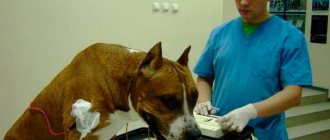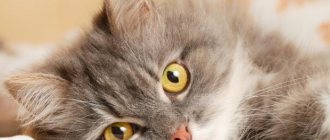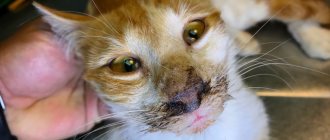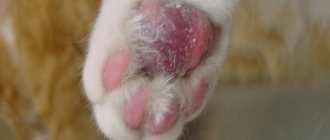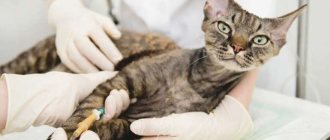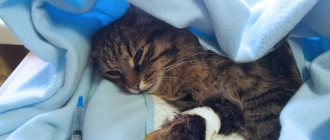- VetConsultPlus
- Informational portal
- Cat diseases
First of all, the main myth should be debunked - heart murmur in cats is not always associated with cardiac pathology
. If a cat's heart murmur is detected in obesity, there may be two options: the cat has concomitant heart pathology, the cat may be healthy, and the murmur may be physiological. In any case, obesity cannot in any way affect the development of cardiac pathologies and lead to heart murmur.
However, heart murmurs can occur in cats as a result of congenital and acquired myocardial diseases. Most often, the cause of murmurs is hypertrophic (obstructive) cardiomyopathy, and their intensity can be variable and depends on the state (calm or stressed) the cat was in during auscultation. The absence of an audible heart murmur does not exclude the presence of severe myocardial damage in the examined animal (Paige CF, Abbott JA, Elvinger F, et al. Prevalence of cardiomyopathy in apparently healthy cats. J Am Vet Med Assoc 2009).
Diastolic gallop rhythm
(manifested by an increase in the third or fourth heart sound) does not occur in healthy cats; its appearance indicates a decrease in the level of relaxation and/or a decrease in the distensibility of the walls of the left ventricle of the heart. This abnormal heart rhythm serves as an indicator of diastolic dysfunction, as well as acute decompensation or the approaching point of its transition to congestive heart failure. These sounds should not be confused with arrhythmia. Signs of congestive heart failure: left-sided congestive heart failure is clinically manifested by pulmonary edema (weak increased breathing or severe shortness of breath, crepitus, detected by auscultation of the lung area during inspiration).
Signs of right-sided and bilateral ventricular failure in cats tend to be less noticeable, often limited to distension of the jugular veins or positive hepatojugular reflux (Hanas S, Tidholm A, Egenvall A, et al. 24 hour Holter monitoring of un-sedated healthy cats in the home environment. J Vet Cardiol 2009). Pleural effusion is the most common clinical manifestation of bilateral ventricular failure.
Hyperthyroidism - relatively often causes extrasystole and secondary cardiomyopathy
, therefore, in all suspicious cases, cats are recommended to carefully palpate the neck area (Cote E. Feline arrhythmias: an update. Vet Clin North Am Small Anim Pract 2016.).
Electrocardiographic examination and diagnosis of heart murmur in cats
Once a cardiac arrhythmia has been detected in an animal by auscultation, it is necessary to conduct a standard six-lead electrocardiographic study to confirm the presence of this pathology, determine its nature, assess its clinical significance and diagnose difficulties, since the complexes of low-voltage electrocardiogram waves in cats remain normal.
To assess heart rate, determine the standard complex of amplitudes and the wave width of lead II
, but for the same purpose, you can analyze any other lead with optimized P-waves and QRS complexes. Although electrocardiography is not a sensitive enough method for detecting enlargement of the heart chambers, unlike, for example, ultrasound cardiography, it still provides certain capabilities: detection of high R-waves (enlargement of the left ventricle of the heart) and high and/or wide P-waves (enlargement of the atria, although these changes are specific only to enlargement of the left or both atria, not the right atrium). The electrocardiogram may show changes accompanying myocardial hypoxia/ischemia (in particular, changes in the ST segment).
Main symptoms
Symptoms, signs, and clinical manifestations of cardiac pathologies are ambiguous. The general picture, the intensity of symptoms depends on age, conditions of detention, the presence of secondary, concomitant systemic diseases, general physiological condition, individual characteristics, form, and the root cause of the disease.
Often, owners detect symptoms of heart disease when they enter the chronic stage, which can end tragically for their pet. Therefore, always carefully monitor the behavior and condition of your furry pet, and if there are any signs of discomfort or worsening of the condition, contact a veterinarian.
Important! Pathologies and diseases of the cardiovascular system can manifest themselves in cats of different age groups. Heart diseases are not always detected in elderly, old animals.
Signs of heart disease and pathologies in cats:
- weakness, decreased activity, lethargy, drowsiness;
- weak reaction to external stimuli;
- refusal to eat;
- heart rhythm disturbances (arrhythmia, tachycardia);
- fainting, signs of suffocation;
- breathing problems (shortness of breath, rapid breathing, cough);
- wheezing in the sternum, wheezing;
- pallor, cyanosis of mucous membranes;
- swelling on the body, ascites;
- dry nose;
- heart murmurs on auscultation;
- weight loss;
- fainting, convulsions, muscle spasms;
- temperature drop;
- violation of movement coordination.
Cats suffering from heart pathologies get tired quickly after active games or short activity. Animals may take unnatural positions and refuse food or treats offered.
Touching the sternum causes pain. Breathing is rapid (more than 35-40 breaths per minute at rest), shallow. Respiratory rate is measured by chest movement.
Important! The respiratory rate of cats is affected by weight, age, ambient temperature, and the condition of the animal. Thus, in pregnant and lactating cats, and in pets after physical activity, the respiratory rate is increased.
Due to oxygen starvation, animals stretch their necks forward and breathe with an open mouth. Cats often have swelling in their limbs and muzzle. Body temperature is unstable and in most cases low.
Heart pathologies in cats often cause convulsions, which are in many ways similar to epileptic seizures. Animals with heart failure try to move as little as possible and avoid physical activity. Possible loss of coordination of movements, frequent sudden fainting caused by dizziness, paralysis of the hind legs.
Given the non-specificity of symptoms, it is very important to carry out comprehensive diagnostic measures in the clinic as quickly as possible. Diagnosis of heart pathologies in animals is quite complex, is carried out using special equipment and requires highly qualified veterinarians.
Ultrasound cardiography (echocardiography) and diagnosis of heart murmur in cats
Ultrasound scanning, which allows you to determine the size of the chambers and the thickness of the walls of the heart
, as well as evaluate the systolic phase of its activity. Ultrasound cardiography provides the ability to detect any effusions (pleural and pericardial). Doppler echocardiography is used to assess diastolic dysfunction and pressure in the blood-filled chambers of the heart (Schober KE, Fuentes VL, Bonagura JD. Comparison between invasive hemodynamic measurements and noninvasive assessment of left ventricular diastolic function by use of Doppler echocardiography in healthy anesthetized cats. Am J Vet Res 2015;64:93-103).
In addition, in cases of severe left atrial enlargement and atrial dysfunction, spontaneous echo contrast (“haze”) of images may appear; In such situations and when blood clots are detected in the heart, the risk of systemic thromboembolism in cats is high. With hypertrophic cardiomyopathy, this species of small domestic animals exhibits atherosclerosis (Fox PR, Liu SK, Maron BJ. Echocardiographic assessment of spontaneously occurring feline hypertrophic cardiomyopathy; an animal model of human disease. Circulation 2015), which can lead to the development of myocardial infarction. In such cases, cats may experience ventricular arrhythmias and show signs of recent myocardial infarction.
Pericarditis in cats
Content
- Causes of pericarditis
- Consequences
- Clinical signs
- Diagnostics
- Treatment
What is pericardial effusion ?
Pericardial effusion refers to an abnormal accumulation of fluid in the pericardial sac.
The pericardial sac or pericardium is the cavity surrounding the heart. Typically, this cavity contains only a small amount of clear fluid to allow the heart to lubricate and glide within the sac. With pericardial effusion, excess fluid accumulates in the pericardial sac, preventing the heart from functioning normally.
Pericardial effusion is rare in cats.
Causes
What causes pericardial effusion?
Pericardial effusion has a number of underlying causes.
In cats, the most common cause of pericardial effusion is heart failure. It is often associated with hypertrophic cardiomyopathy, the most common heart disease in cats.
The second most common cause of pericardial effusion in cats is cancer, including tumors of the heart or pericardium.
Less commonly, pericardial effusion in cats can be caused by infection or a birth defect known as peritoneopericardial diaphragmatic hernia.
Pericardial effusion can also be idiopathic, i.e. the reasons for its development remain unknown.
Consequences
What are the consequences of pericardial effusion??
As the pericardial cavity fills with excess fluid, the pressure within the pericardial cavity increases. Eventually, this pressure can equal or even exceed the pressure in the chambers of the heart. In this situation, the ventricles of the heart lose their ability to fill effectively, and a condition known as cardiac tamponade develops. Cardiac tamponade impairs the heart's ability to pump blood, leading to right-sided congestive heart failure, low blood pressure, and decreased circulation to the heart and other organs.
In some situations, this fluid accumulation occurs quickly. This can lead to rapid development of clinical signs. In other situations, fluid accumulates slowly. This gives the body more time to adapt and compensate.
Clinical signs
What are the clinical signs of pericardial effusion?
Signs of pericardial effusion can vary significantly depending on the severity and timing of the disease.
Early signs often include fluid accumulation in the abdomen and subsequent visible abdominal enlargement and exercise intolerance. In some cases, fainting may occur during exercise. A cough and decreased appetite may also occur.
In severe cases, especially those with acute onset, pericardial effusion can cause sudden collapse and death without any prior symptoms.
Diagnostics
How is pericardial effusion diagnosed?
During a physical examination, your doctor may notice a number of symptoms that may suggest pericardial effusion. Affected cats often have pale gums and a decreased pulse wave. Breathing may be difficult, with an abnormally increased breathing rate. Auscultation may reveal muffled heart sounds caused by fluid accumulated around the heart. Other symptoms may include an enlarged liver and fluid in the abdomen. All of these signs are associated with the heart's inability to pump blood normally throughout the body.
If pericardial effusion occurs secondary to infection, physical examination may also reveal fever.
If the doctor suspects a pericardial effusion, a number of tests will likely be performed. These tests may include:
- Clinical and biochemical blood tests to assess the general health of the cat.
- Blood pressure measurement. Low blood pressure supports the diagnosis of pericarditis and cardiac tamponade.
- Chest X-ray. Cats with pericardial effusion may have a characteristic cardiac appearance on radiographs, which will help confirm the diagnosis. However, it is important to note that a chest x-ray cannot accurately diagnose pericardial effusion and does not provide any information about how well the heart is working.
- Cardiac ultrasound is the method of choice for diagnosing pericardial effusion and also provides information about how efficiently the heart is working.
- Analysis of pericardial fluid. If a pericardial effusion is diagnosed, a sample taken from the fluid around the heart can be analyzed to determine the cause of the effusion. Fluid analysis does not always provide an accurate diagnosis, but can be especially useful in diagnosing certain conditions (lymphoma and infective pericarditis).
How is pericardial effusion treated?
Whenever possible, pericardial effusion is treated by treating the underlying disease. This is especially important if the effusion is associated with heart failure, which can be controlled with drug therapy.
If your cat is critically ill due to cardiac tamponade, the doctor may try to remove the fluid surrounding the heart. This procedure is called pericardiocentesis. Pericardiocentesis can be performed under ultrasound guidance. It is important to understand that pericardiocentesis does not treat pericardial effusion.
The underlying cause of the effusion should be identified and treated if possible, as it may recur. This procedure, however, may increase your cat's chances of surviving a critical illness.
Treatment
If the pericardial effusion is due to a tumor, treatment options vary depending on the type of tumor. In some cases, surgical treatment may be undertaken, while other patients may be treated with chemotherapy.
In some cases, pericardial effusion can be treated with a procedure called pericardiectomy. In a pericardectomy, a small hole (window) is made in the pericardium. This allows accumulated fluid to drain from the pericardium into the surrounding tissue, reducing pressure on the heart. In some cases, this treatment is the treatment of choice and helps avoid relapses of tamponade.
If the pericardial effusion is associated with a peritoneopericardial diaphragmatic hernia, surgery to correct the hernia is required.
What is the prognosis for pericardial effusion??
The prognosis depends on the underlying cause.
Oncologic causes of pericardial effusion vary in response to treatment and rate of disease progression. The prognosis for tumor-induced pericardial effusion depends on the specific tumor type. Most are non-cancerous.
The article was prepared by doctors of the cardiology department of “MEDVET” © 2014 SEC “MEDVET”
Good to know
- Why do cats hide pain?
- Serval cats
- Cat urine retention
- Causes of pain syndrome in cats
- Feline Orofacial Pain Syndrome
- Catnip for cats
- How to care for an old cat?
- How to properly dry a cat?
- How to Choose a Kitten for your Home
- Pneumonia of Cats
- Causes of Sneezing in Cats
- Anatomy and physiology of the liver in cats
- The structure and functions of the thyroid gland in cats
- Measuring blood pressure in cats
- Dexmedetomidine in clinical veterinary and medical anesthesia and intensive care
- Thyroid function testing in cats
- Gabapentin in cats and dogs
- Information content of hematological and echocardiographic preoperative screening indicators
- Historical background on hyperthyroidism in cats
- Hyperthyroidism in older cats
- Cardiac hypertrophy in cats
- Analysis of anamnestic data during preoperative examination of animals
- Study of anamnestic data in cats before general anesthesia
- Method for measuring blood pressure in cats
- ICD in cats
- Hyperthyroidism with normal serum T4 concentration
- Acute gastroenterocolitis in dogs (etiology, pathogenesis, diagnosis and treatment)
- Reducing mortality during anesthesia is an important task of veterinary anesthesiology
- Thrombosis in cats (general information, etiology, pathogenesis, clinical picture, diagnosis and treatment)
- Urolithiasis of small animals (etiology, pathogenesis, diagnosis and treatment)
- Congestive cardiomyopathy in cats (What is it? How to protect your pets)
- Gastrointestinal tract in dogs (anatomy and physiology)
Diagnosis of cardiac pathologies
It is impossible to independently determine cardiac pathology in a pet without experience and special equipment. Heart disease, even in its early stages, may not manifest itself for several years. This is why it is very important to take your pet at least once a year for a checkup.
The diagnosis is made taking into account the combination of a number of studies, which include:
- ECHO (echocardiography).
- ECG (electrocardiography). The electrical activity of the heart is measured.
- MRI, CT.
- Tonometry.
- Physical research.
- X-ray. This technique allows you to determine the size and shape of the heart.
- Laboratory tests (serological studies).
In addition to the basic techniques, the doctor collects medical history data and takes into account the specifics of clinical manifestations.


